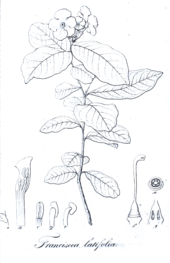Brunfelsia latifolia
| Brunfelsia latifolia | ||||||||||||
|---|---|---|---|---|---|---|---|---|---|---|---|---|

Bloom of Brunfelsia latifolia |
||||||||||||
| Systematics | ||||||||||||
|
||||||||||||
| Scientific name | ||||||||||||
| Brunfelsia latifolia | ||||||||||||
| ( Pohl ) Benth. |
Brunfelsia latifolia is a species from the Franciscea section of the genus Brunfelsia . The smallest members of the genus with a plant height of 0.2 to 1 m are endemic to the area around Rio de Janeiro .
description
Vegetative characteristics
Brunfelsia latifolia is a 0.2 to 1 m high shrub with a strongly branched habit. The branches arise near the base, are often zigzag-shaped and covered with leaves . The bark is thin, light brown to grayish in color. The young twigs are light brown, the distance between the internodes is about 1 cm.
The leaves vary greatly in their shape, they are almost sessile, the petiole is only 1 to 4 mm long, hairless and dark purple in color. The leaf blade is 4 to 9 cm long and 2.2 to 5.5 cm wide, elliptical to elongated or ovate to inversely ovate. Towards the front, the leaf is pointed, blunt or rounded, occasionally provided with a small point or bulged. The leaf base is blunt to wedge-shaped, rarely cut off. The upper side of the leaf is matt or glossy dark green, the underside matt and light green. Occasionally there are some fine trichomes along the midrib . On each side of the leaf, five to eight side veins extend from the midrib, most of which are straight.
Inflorescences and flowers
Plants of the species can bloom at a height of only 30 cm. The terminal, compact inflorescences consist of three to 20 non-scented flowers . The inflorescence axis is 3 to 7 mm long and hairless. Below each flower are one or two foliage-like bracts that are 1 to 10 mm long, lanceolate and ciliate. The flower stalks are light green, 6 to 8 mm long, slender and hairless or sparsely hairy with glands, the stalk becomes thicker on the fruit.
The calyx is 9 to 13 mm long, tubular-bell-shaped, hairless or slightly hairy with glands, light green and smooth. The calyx teeth are 2 to 3 mm long, upright or bent back, triangular to lanceolate. They are pointed at the top. On the fruit, the calyx is leather-like, clearly streaked with veins and enclosing the fruit.
The crown is pale purple at first, but fades to white. The corolla tube is 15 to 20 mm long and 2 mm in diameter, about twice as long as the calyx. It is slightly hairy glandular, pale purple at the base, turning white towards the top. The thickening at the transition to the coronet is white, rounded or square. The coronet itself has a diameter of 20 to 30 mm, it protrudes and forms a plane. The underside is white. The crown lobes are almost the same size. The upper corolla lobe is usually slightly smaller, about 5 mm long, the tip is almost cut off. The other corolla lobes are about 8 mm long and rounded at the tip.
The four stamens start in the upper half of the corolla tube and do not protrude beyond it. The stamens are white, slender and cylindrical, 2 mm in the upper pair of stamens; in the other pair only 1 mm long. The anthers are about 1 mm long, circular-kidney-shaped and brown. The ovary is 2 mm high, egg-shaped and pale green. The stylus is slender, white and bent at the tip. The stigma is light green and slightly bilobed, with the lobes of different sizes.
Fruits and seeds
The fruits are capsules enclosed by the calyx with a length of 11 to 13 mm and a diameter of 8 to 10 mm. They are egg-shaped and pointed at the tip, smooth, hairless and dark green. The pericarp is thin-walled, dries up when ripe, crusty and only pops up late.
Each fruit contains around ten to twelve seeds . These are 5 to 6 mm long and 3 mm in diameter. They are elongated-elliptical and angled. The surface is dark brown and grained like a network. The embryo is 4 mm long, almost straight, the cotyledons are 1.5 mm long and ovoid.
Chromosome number
The number of chromosomes is 2n = 22.
Occurrence
The species is endemic in the Brazilian state of Rio de Janeiro , where it grows in the vicinity of the state capital of the same name in bush formations near the sea on sandy soils.
literature
- Timothy C. Plowman (Author), Sandra Knapp, JR Press (Ed.): A Revision of the South American Species of Brunfelsia (Solanaceae) . Field Museum of Natural History, Chicago August 1998, OCLC 39885128 . (Fieldiana Botany, New Series, number 39).
Individual evidence
- ^ Brunfelsia latifolia at Tropicos.org. In: IPCN Chromosome Reports . Missouri Botanical Garden, St. Louis
